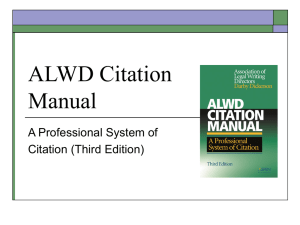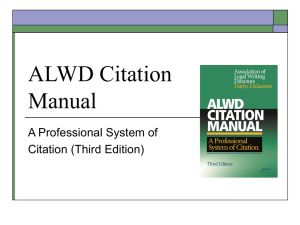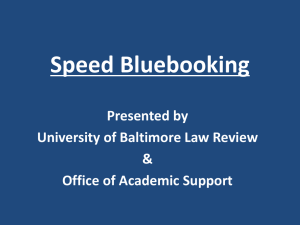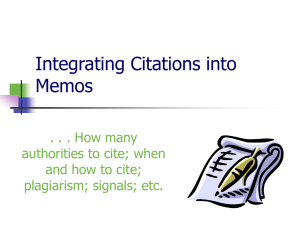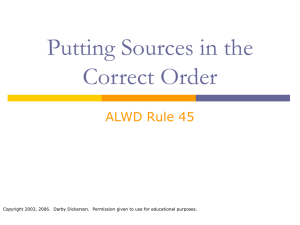Rule 45 – Signals
advertisement
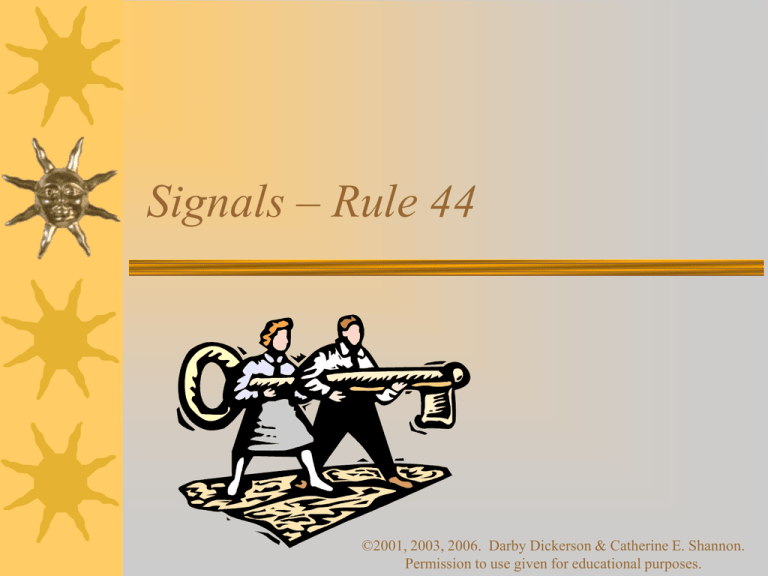
Signals – Rule 44 ©2001, 2003, 2006. Darby Dickerson & Catherine E. Shannon. Permission to use given for educational purposes. Purpose To show the type and degree of support or contradiction the cited authority provides for the accompanying text. Signals “link” the text and the citation. Do Not Use a Signal When . . . The cited authority directly supports the stated proposition. – The court enforced the arbitration clause and thus dismissed the complaint. Jackson v. Nagle, 200 F.3d 12, 17 (3d Cir. 2001). Do Not Use a Signal When . . . The cited authority identifies the source of a quotation. – “We examine the plain language of the statute before we consider legislative intent as reflected in House and Senate reports and floor debates.” U.S. v. Constantine, 12 F. Supp. 2d 451, 457 (D. Mass. 1999). – Any length of quoted material typically suffices for this rule to apply. Do Not Use a Signal When . . . The cited authority merely identifies the authority referred to in the text. – In Smith v. Jones,1 the court held . . . . • 1 300 U.S. 107 (1982). – In 1945, Professor Lee wrote his landmark treatise on international relations.4 • 4 Chonchung Lee, International Relations in the Modern World (World Press, Inc. 1945). Use A signal may be used before a full citation or a short citation. Rule 44.2(c). – See Smith v. Jones, 100 U.S. 300, 307 (1898). – See Smith, 100 U.S. at 307. – See id. Types of Signals: 44.3 Support – [no signal], see, accord, see also, cf. Comparison – compare . . . with Contradiction – contra, but see, but cf. Background information – see generally E.g.: The “Tag Along” E.g. may be used by itself (when “no signal” otherwise would have been used) or with any other signal (see e.g.; cf. e.g.). Using e.g. means you do not want to cite all pertinent cases, but merely a representative sample or example of pertinent cases. The “Different” Signal In determining Rule 44.6 placement, put e.g. where the “other” signal would go: – E.g. (where “no signal” would go) – See e.g. (where see would go) – Contra e.g. (where contra would go) Difference from Bluebook: No commas. – Bluebook version: • E.g., • See, e.g., See Use to reflect (a) implicit support [see example below] or (b) dicta. – A conference of this type does not constitute a "meeting" under the Sunshine Law.12 – 12See Mitchell v. Sch. Bd. of Leon County, 335 S.2d 354, 355 (Fla. 1st Dist. App. 1976) (holding that the Sunshine Law was not applicable to meetings between the superintendent, the director of personnel services, and the school board attorney). Accord and see also Accord = The law of one jurisdiction is similar to that of another jurisdiction. See also = Additional material that supports the proposition, but support is less direct. These signals have the same meaning as in the Bluebook. Cf. Use when the cited source provides support for the sentence only by analogy. – For example, when the sentence concerns premise liability in a residential apartment context, but the cited authority concerns an office building. Cf. means the same thing under ALWD and the Bluebook. Compare . . . with Use to compare authorities or groups of authorities that reach different results concerning the stated proposition. – Courts are split on this issue.45 • 45 Compare U.S. v. Martinez, 157 F.3d 21, 27 (2d Cir. 2000); U.S. v. O’Kelley, 159 F.3d 451, 454 (5th Cir. 2000) (both ruling in favor of the government) with U.S. v. Brownlee, 162 F.3d 166, 167 (8th Cir. 2000); U.S. v. Masterson, 143 F.3d 291, 298 (D.C. Cir. 2000) (both ruling in favor of the defendant). – Compare . . . with means the same thing under the Bluebook, but there is a comma before with under the Bluebook. Negative Signals Use to show that other Contra – Use when the cited authority sources contradict or directly contradicts the stated proposition. disagree with what is But see in the text. – Use when the cited authority The choices parallel (a) contradicts the stated proposition implicitly or (b) the “positive” signals. contains dicta that contradict the stated proposition. But cf. – Use when the cited authority contradicts the stated proposition by analogy. See generally Use to cite helpful background information related to the stated proposition. – Often the cites are to secondary sources. – See generally Paula Q. Author, Treatise ch. 2 (West 1999) (detailing the history of the statute of frauds). Signals and Explanatory Parentheticals: 44.4 It often helps to use an explanatory parenthetical when you use a signal; but, the third edition does not require parentheticals. E.g. would require a parenthetical only when it is combined with another signal. Capitalizing Signals: 44.5 Capitalize the first letter of signal if it begins a citation sentence. – See Smith, 407 F.3d at 33 (describing the “law of the case” doctrine). Do not capitalize the first letter of a signal if it appears within a citation clause or later in a citation sentence (below). – Bethal Sch. Dist. v. Fraser, 478 U.S. 675, 681 (1986); see Hazelwood Sch. Dist. v. Kuhlmerier, 484 U.S. 260, 260 (1988) (indicating that schools should not tolerate student speech that is inconsistent with its “basic educational mission”). Placement and Typeface of Signals: 44.6 Do not include any punctuation after the signal. – Correct: See Smith – Incorrect: See, Smith Italicize each signal . . . unless it’s used as a verb: – For more information on this topic, see Part IV of this Article. • Do not italicize “see” in this context. Repeating Signals: 44.7 If more than one authority provides the same type and degree of support for the stated proposition, do not repeat the signal before each authority. – A signal “carries through” until a different signal is used. – See the example on ALWD p. 326 (third edition). Order of Signals: 44.8 Signals should appear in the order they are listed in Rule 44.3. – “No signal” always comes first. – Other examples: See before contra before see generally When e.g. is combined with another signal, the combined signal should appear where the non-e.g. signal normally would fall. Punctuation Between Signals: 44.8(c) Separate different signals and their accompanying citations with a semicolon and one space. The Bluebook is different. Under Rules 1.2 and 1.3, you separate signals of the same type with a semicolon, but signals of different types with a period. Remember Related Rules Rule 45: Order of authorities within a signal. Rule 46: Explanatory parentheticals.
